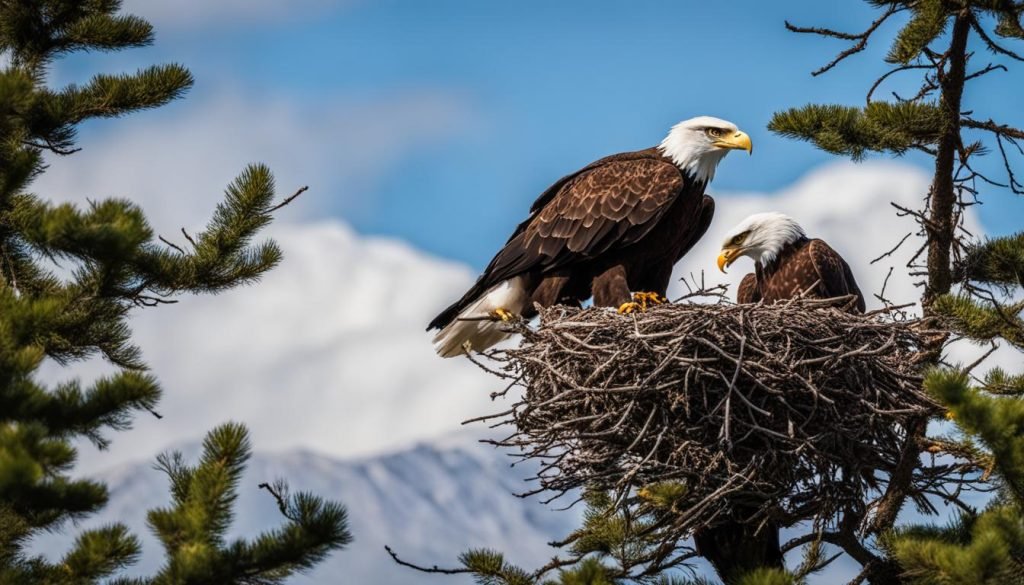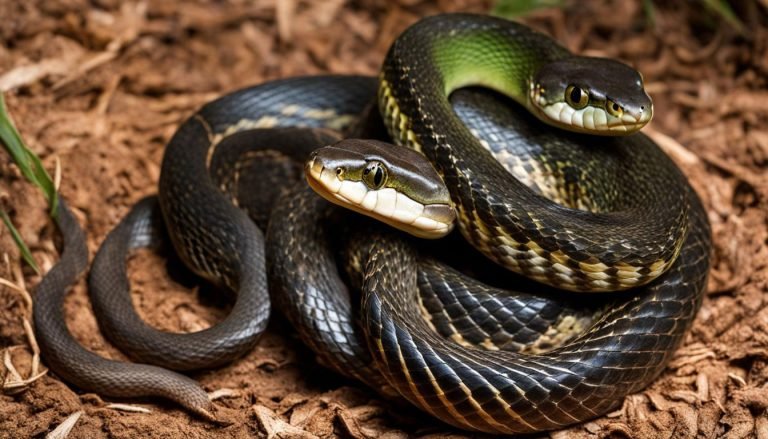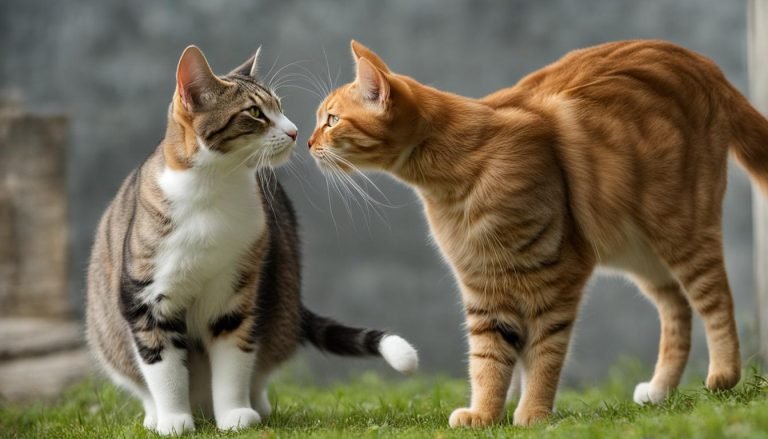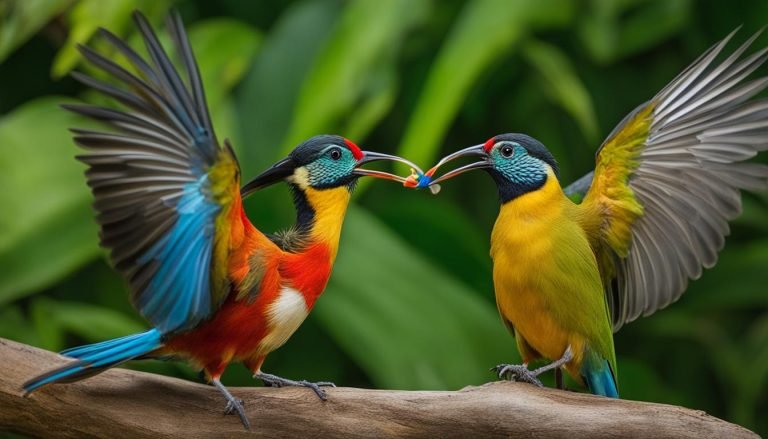How Do Eagles Mate? Reproduction Process Explained
Eagles are one of the most fascinating creatures on the planet. These majestic birds of prey are known for their incredible hunting skills and impressive wingspans. But have you ever wondered how eagles mate? In this article, we will explore the intricate mating rituals of eagles and shed light on their unique reproductive behaviors.
Key Takeaways:
- Eagles engage in elaborate courtship rituals during mating season
- They build intricate nests and are fiercely territorial during the breeding season
- Eagles copulate in mid-air, performing acrobatic maneuvers to ensure fertilization
- Both male and female eagles play important roles in parenting their offspring
- Conservation efforts are crucial for the survival of eagle populations
Eagle Quiz
How well do you know eagles? Test your knowledge here!

Eagle Mating Season and Courtship Behavior

For eagles, mating season is a time of elaborate courtship rituals and behaviors that are both fascinating and unique. Eagle mating rituals typically occur between November and March, depending on the species and geographic location.
During the mating season, eagles engage in complex courtship displays that involve a variety of behaviors. These displays serve to attract potential mates while also establishing dominance within the eagle community. Some of the most common courtship behaviors exhibited by eagles include:
- Clawing: Male eagles will claw at the female’s back during copulation, holding on tightly to ensure successful fertilization.
- Dancing: Eagles engage in intricate mating dances that involve swooping flights, aerial acrobatics, and coordinated movements.
- Calls and vocalizations: Eagles produce a variety of vocalizations during the mating season, ranging from high-pitched screams to low-frequency hoots.
Male eagles typically initiate the courtship process, displaying their strength and agility to attract potential mates. Female eagles will respond to these displays by engaging in their courtship behaviors, such as circling and diving in mid-air. These courtship displays can last for hours or even days, and serve as a crucial prelude to copulation.
Once a pair of eagles has mated, they will remain together for the duration of the breeding season, sharing the responsibilities of nest-building, incubation, and chick-rearing.
“Eagles engage in complex courtship displays that involve a variety of behaviors.”
Overall, eagle mating rituals and courtship behavior are intricate and highly evolved, reflecting the unique adaptations that these birds have developed over time to ensure successful reproduction and survival.
Eagle Breeding Habits and Nesting Behavior

Eagles are renowned for their exceptional parenting skills, and their breeding habits play a significant role in their success in raising their offspring. Eagles mate for life and typically produce one to three eggs each season, depending on environmental factors such as food availability and weather conditions.
Female eagles are primarily responsible for the construction of the nest, which can take several weeks or even months to complete. The nests are typically composed of sticks, twigs, and grass, and are lined with softer materials such as moss and feathers to provide insulation for the eggs and fledglings. These nests can grow to enormous size, with some exceeding a width of six feet and weighing over a ton.
Eagle nesting sites are located in high places, typically on cliff faces or in the tops of tall trees. This is an important consideration for the birds because it provides them with a strategic advantage against potential predators and allows them to monitor their environment for potential prey. Eagles are known for their fierce territorial behavior and will staunchly defend their nests against any perceived threats.
Once the eggs are laid, both the male and female eagles will take turns incubating them for approximately 35 days. During this time, they will carefully regulate the temperature of the eggs and protect them from predators and the elements. After the eggs hatch, the parents will continue to provide diligent care and protection for their offspring until they are ready to fledge or leave the nest, at around 10-12 weeks of age.
Eagle Reproduction Process and Copulation Techniques
Eagles are monogamous birds known for their elaborate courtship rituals and mating dances. Once a pair has formed, they will remain together for life and engage in an annual breeding cycle. The eagle reproduction process begins with courtship behavior, moves on to copulation, and ultimately results in the female laying eggs.
The courtship phase involves a series of behaviors that are designed to establish and strengthen the bond between the male and female eagles. During this time, they engage in playful displays, vocalizations, and aerial acrobatics. These courtship rituals can continue for several weeks or even months, ensuring that the eagles are ready to mate.
When it comes time to copulate, the male eagle will climb onto the back of the female and use his talons to grip her wings. This position is known as the “cloacal kiss,” and it allows the male to transfer his sperm to the female’s reproductive tract. Copulation can last anywhere from a few seconds to a few minutes, with the male dismounting once the transfer is complete.
After copulation, the female eagle will begin developing her eggs. Unlike other birds, eagles have a delayed fertilization process, meaning that the sperm may not fertilize the egg until several days after copulation. During this time, the female will nest in preparation for the arrival of her offspring.
“Eagles are known for their elaborate courtship rituals and mating dances.”
Once the eggs have been fertilized, the female eagle will lay them in her nest, where she will spend the next several weeks incubating them. Depending on the species, eagles may lay anywhere from one to four eggs, with the larger species typically producing smaller clutches.
Overall, the eagle reproduction process is a complex and fascinating series of events that ensures the survival of these magnificent birds. From courtship to copulation, eagles exhibit a wide range of behaviors that are both unique and awe-inspiring.
How Do Eagles Mate: Eagle Territoriality During Mating

Eagles are fiercely territorial and defend their nests and territories vigorously during the breeding season. This territorial behavior is particularly pronounced during mating, as eagles compete for mates and resources. This territoriality helps ensure the survival of their offspring and maintain healthy populations of eagles.
Male and female eagles have distinct roles in territorial defense. Males are typically responsible for defending the nest itself, while females defend the surrounding territory. This division of labor allows for maximum protection of the young and ensures that both parents are involved in the breeding process.
The size of an eagle’s territory can vary depending on the abundance of resources in the area. Eagles will defend territories with ample food sources, suitable nesting sites, and protection from predators. In areas with limited resources, territories may be smaller and more fiercely defended.
Eagles use a variety of visual and vocal displays to defend their territories during mating. They may engage in aerial displays, such as soaring, diving, and swooping, to show off their strength and agility. They also use vocalizations, such as piercing screeches and guttural calls, to communicate with other eagles and assert their dominance.
“During mating season, eagles are highly committed to protecting their nests and territories, often engaging in elaborate displays of strength and dominance.”
Despite their fierce territoriality during the breeding season, eagles typically return to their nesting sites year after year and may even mate with the same partner for life. This strong sense of loyalty to their territories and mates is one of the many unique and fascinating characteristics of these majestic birds.
Eagle Mating Dances and Displays
Eagles are known for their intricate mating dances and displays, which serve to attract and impress potential mates. These dances are often performed during courtship and are executed with precision and grace.
Male eagles typically initiate the dance, using a variety of movements to showcase their strength and agility. One common display involves the male eagle soaring high into the sky, then diving down towards the female to demonstrate his impressive hunting skills.
Another popular dance move involves the male eagle grasping a stick or other object in his talons and dropping it mid-air, only to swoop down and catch it again with ease. These displays are a testament to the eagle’s physical prowess and serve to impress potential mates with their strength and agility.
Female eagles also play a vital role in the mating dance, responding to the male’s advances with their graceful movements. They may use vocalizations or body language to communicate their interest or engage in a synchronized dance with the male eagle.
These mating dances and displays are not only visually stunning but are also a crucial aspect of eagle reproduction. By showcasing their strength and agility, male eagles can attract high-quality mates and increase their chances of reproductive success.
The Role of Eagles in Parenting
Eagles are renowned for their fierce dedication to parenting and offspring care. Both male and female eagles play essential roles in raising their young, with each parent assuming unique responsibilities throughout the process.
Female eagles are responsible for incubating the eggs, a process that typically lasts between 35-45 days. During this time, the male eagle provides her with food and protects the nest from potential predators.
Once the eggs hatch, both parents continue to work together to care for their offspring. The male eagle hunts and brings food back to the nest, while the female eagle feeds and tends to the eaglets. She also keeps the nest clean and ensures that the eaglets remain warm and dry.
As the eaglets grow, both parents gradually reduce their feeding frequency and begin to encourage them to hunt for their food. This process of teaching the young eagles to become independent can take several weeks or months, depending on how quickly they learn.
As the eaglets mature, they begin to exercise their wings and prepare for their first flight. The parents continue to provide guidance and support, with the male eagle often taking on more of the responsibility for hunting and providing food while the female eagle helps the young birds build up their strength and coordination.
Overall, the role of eagles in parenting highlights the remarkable dedication and nurturing instincts of these magnificent birds. Through careful attention and teamwork, eagles can raise healthy and independent offspring that will one day carry on the cycle of life.
The Circle of Life: Conservation and Longevity
As majestic as eagles are, they face several threats to their survival. Habitat loss, hunting, and pollution have all taken a toll on eagle populations across the globe. Fortunately, conservation efforts have made a significant impact in protecting and preserving these remarkable birds.
Organizations such as the American Eagle Foundation and the National Audubon Society have dedicated themselves to eagle conservation. Through habitat restoration and education initiatives, these groups have helped to increase eagle populations and raise awareness about the importance of protecting these birds.
In addition to conservation efforts, eagles have also benefitted from their impressive longevity. Eagles have been known to live up to 30 years in the wild, with some captive eagles living even longer. These long lifespans have allowed eagles to play a crucial role in their ecosystems for many years, contributing to the overall health of their habitats.
As we continue to learn more about eagles and the vital role they play in our environment, we must work to protect and preserve these magnificent birds for generations to come. Through our collective efforts, we can ensure the continued survival of these iconic creatures and celebrate the beauty and wonder of nature’s dance.







